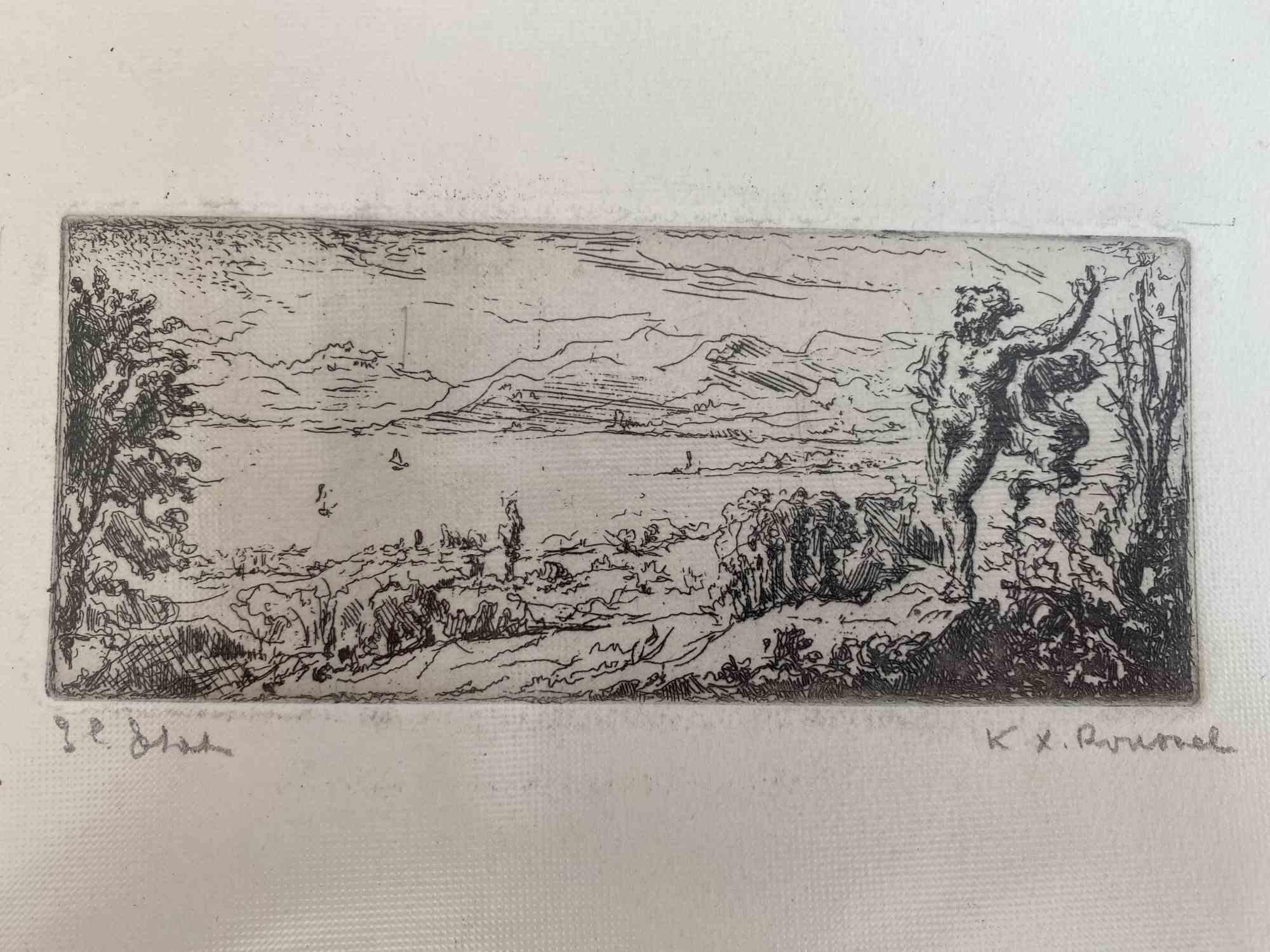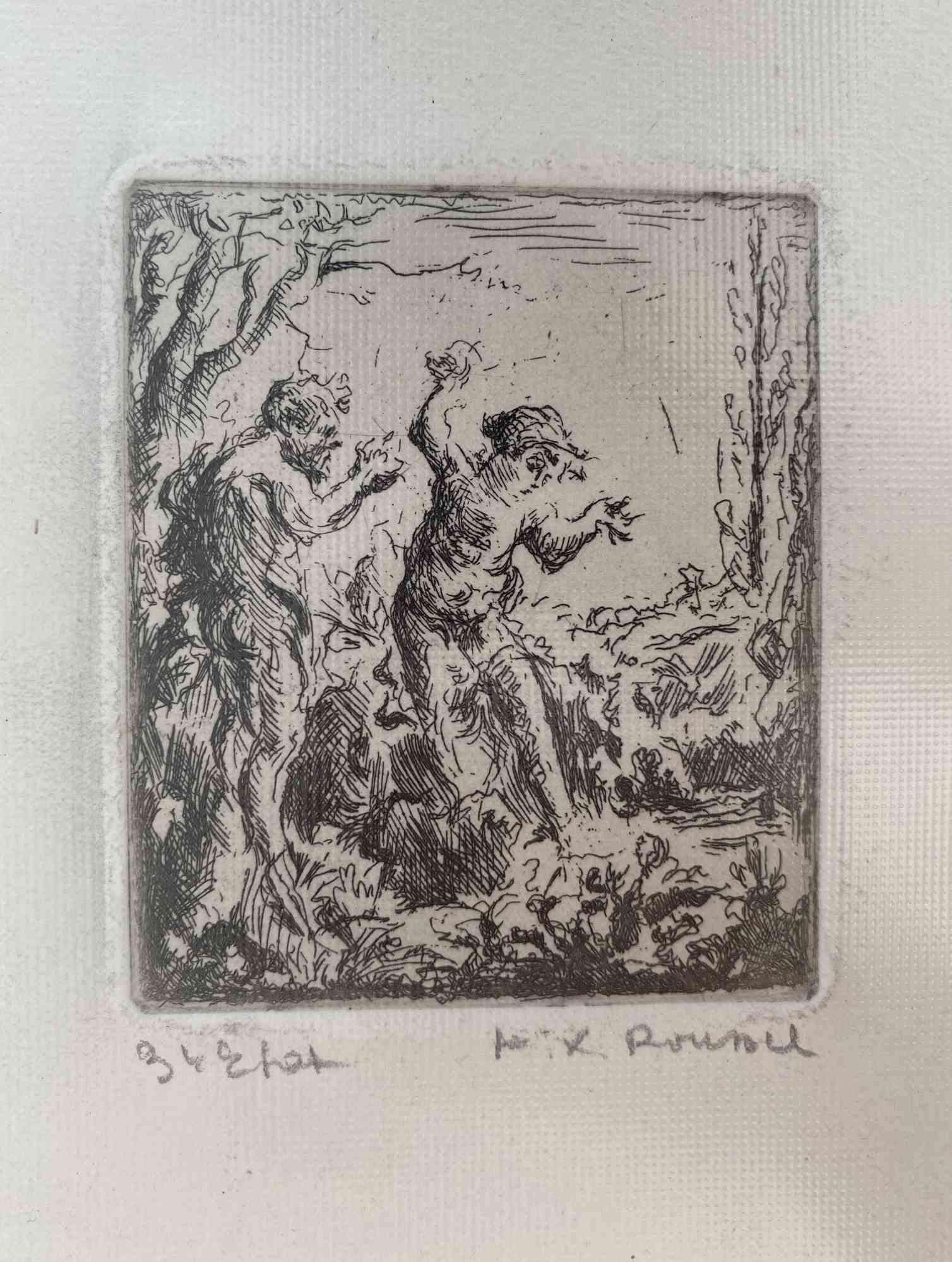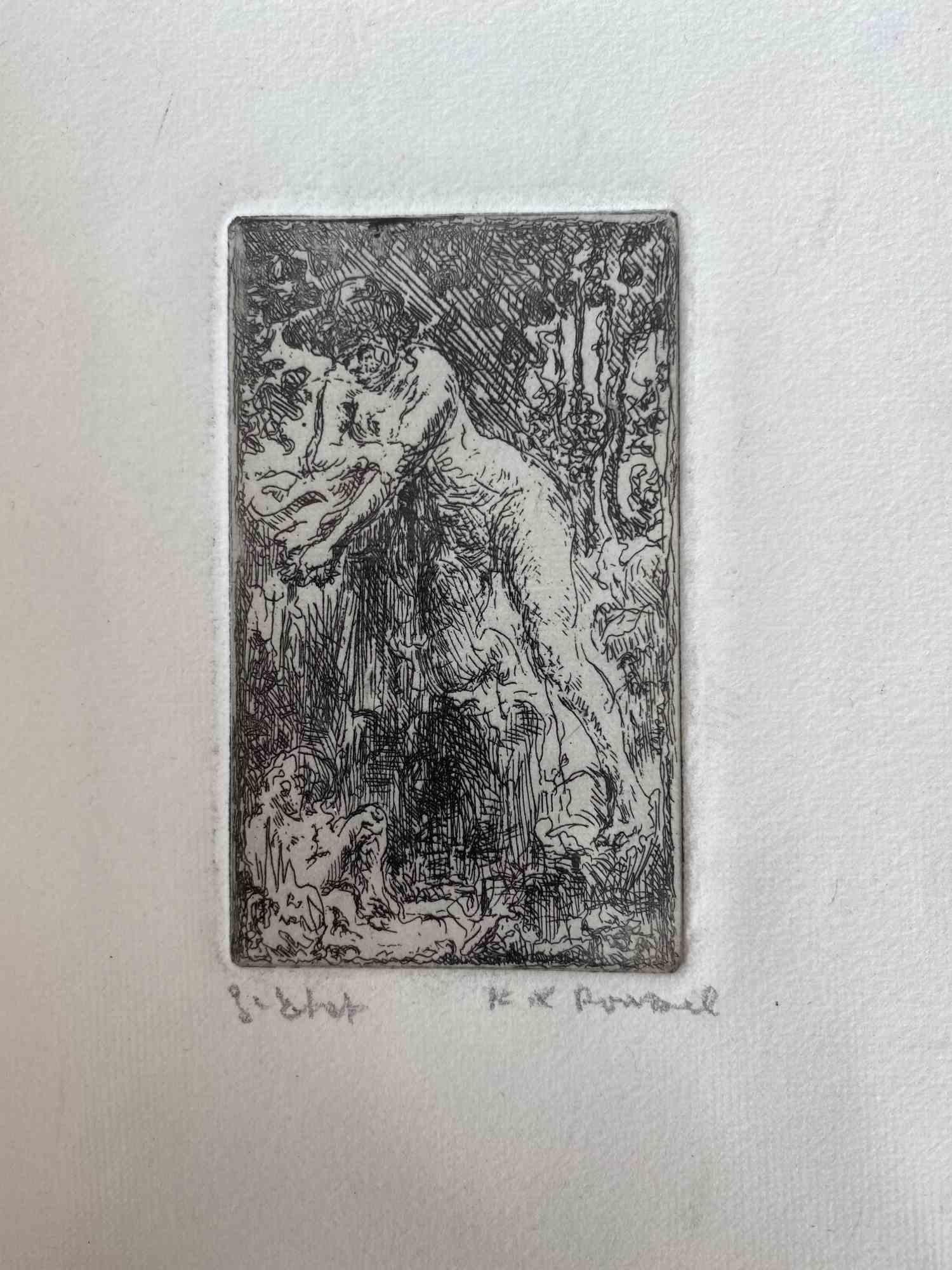André DerainAndré Derain - Ovid's Heroides - Original Etching1938
1938
About the Item
- Creator:André Derain (1880-1954, French)
- Creation Year:1938
- Dimensions:Height: 12.6 in (32 cm)Width: 9.85 in (25 cm)Depth: 0.04 in (1 mm)
- Medium:
- Movement & Style:
- Period:
- Condition:
- Gallery Location:Collonge Bellerive, Geneve, CH
- Reference Number:1stDibs: LU16122271571
André Derain
André Derain is best known as a leading figure of the avant-garde movement and — alongside Henri Matisse — a cofounder of Fauvism at the turn of the 20th century. Derain’s innovative use of expressive colors and simplified forms in his figurative paintings, landscapes and portraits continue to dazzle collectors and art enthusiasts everywhere.
Born in 1880 in Chatou, France, Derain began his formal art training at age 18 at the Académie Camillo, where he met Matisse and Maurice de Vlaminck. In 1905, Derain, Matisse and de Vlaminck exhibited their works at the Salon d’Automne in Paris, where critic Louis Vauxcelles used the word fauves (wild beasts) to describe the loosely connected collective of artists’ prioritization of audacious, vivid color in their energetic works, eventually leading to wide adoption of the term Fauvism.
In 1905 and 1906, Derain traveled to London, where he produced a series of Fauvist “form through color” paintings. These included The London Bridge, Charing Cross Bridge and A Corner of Hyde Park. After seeing a retrospective of Paul Gauguin’s work, Derain painted The Dance, a nude that is demonstrative of Gauguin’s influence in its bold, flat colors and in Derain’s depiction of primitive dancing figures.
In 1910, Derain destroyed many of his unsold works and began painting landscapes in the Cubist style of Paul Cézanne. He befriended Pablo Picasso and grew interested in African tribal art. After World War I, he focused on figurative and nude drawings and, in the early 1920s, abandoned Fauvism and Cubism altogether in favor of classical art. In 1930, the artist publicly condemned modernism, leading to his ostracization by the avant-garde community.
Derain was later honored with a retrospective of his works at the Kunsthalle in Bern, Switzerland. Additionally, the Exposition des Artistes Independants invited Derain to exhibit in 1937.
Derain’s wide range of styles — from Fauvism and Cubism to classicism and Postimpressionism — influenced many artists throughout his lifetime. Today, Derain’s work is held in the permanent collections of the Museum of Modern Art in New York, the Tate gallery in London, the Musée d’Orsay in Paris and the State Hermitage Museum in St. Petersburg.
On 1stDibs, discover original André Derain prints, drawings and paintings.
- ShippingRetrieving quote...Ships From: Collonge Bellerive, Geneve, Switzerland
- Return PolicyA return for this item may be initiated within 7 days of delivery.
- Ossip Zadkine - Ultimate Step - Original EtchingBy Ossip ZadkineLocated in Collonge Bellerive, Geneve, CHEtching monogrammed in the plate. Illustration for a Robert Ganzo's poem "Lespugue" Editions Marcel Sautier, Paris, 1966. Conditions: Good Conditions Dimensions: 25,5 x 16,5 cm. Vellum paper Référence Czwiklitzer n°55. 1890 Zadkine was born on the 14th of July in Vitebsk, a city in Belarussia, on the Dvina. His father Ephime teaches classical languages at the local seminar. His mother Sophie Lester descended from Scots, who emigrated at the time of Peter the Great. 1905 His parents send him to Sunderland, in the North of England, where his mother’s family lives. He studies English and attends modelling courses at the local Art School. 1905-1909 He travels to London without his parents permission where he attends courses at the Regent Street Polytechnicum. In order to earn his living, he plans to work with a stonecutter. He visits the British Museum and studies classical sculpture there. Returns to Smolensk where he produces his first sculpture. Goes back to London. 1909-1910 Zadkine settles in Paris and studies in the ecole Nationale des Beaux-Arts. Finds a workshop in a building called La Ruche, in the XVe arrondissement. 1911 Zadkine presents statues and drawings at the annual Salon d’Automne and at the Salon des Indépendants. It is the ‘cubists’ who draw his attention in Paris. Is essentially close to Russian students who get together in a cafe of the ‘Quartier Latin’. Has himself called Joe Zadkine until 1914. 1912-1913 Finds a room in the neighbourhood of Montparnasse, in the rue de Vaugirard. Studies Roman sculpture. Zadkine is immortalized by his neighbour, photographer Marc Vaux, in his new workshop. Meets Brancusi, Guillaume Apollinaire, Jacques Lipchitz, Pablo Picasso, Antoine Bourdelle, Leopold Survage and Robert Delaunay. Henri Matisse visits Zadkine’s workshop. 1914-1915 Exhibition at the Freie Sezession in Berlin, at De Onafhankelijken in Amsterdam (Holland) and at the Allied Artists Association in London. Thanks to collector Paul Rodocanachi, he can settle in a workshop in the rue Rousselet. Becomes friends with Modigliani. 1916-1917 Works as a stretcher-bearer on the front. Produces drawings and watercolours dealing with war. Zadkine is discharged in 1917. He says he is ‘bodily and spiritually’ ruined by the war. After his stay in the Epernay hospital he recovers in Bruniquel, in the southwest of France. 1918-1919 Makes a series of 20 war etchings...Category
1960s Modern Figurative Prints
MaterialsEtching
- André Derain - Ovid's Heroides - Original EtchingBy André DerainLocated in Collonge Bellerive, Geneve, CHAndré Derain - Ovid's Heroides Original Etching Edition of 134 Dimensions: 32 x 25 cm Ovide [Marcel Prevost], Héroïdes, Paris, Société des Cent-une, 1938 Andre Derain was born in 1...Category
1930s Modern Nude Prints
MaterialsEtching
- André Derain - Ovid's Heroides - Original EtchingBy André DerainLocated in Collonge Bellerive, Geneve, CHAndré Derain - Ovid's Heroides Original Etching Edition of 134 Dimensions: 32 x 25 cm Ovide [Marcel Prevost], Héroïdes, Paris, Société des Cent-une, 1938 Andre Derain was born in 1...Category
1930s Modern Nude Prints
MaterialsEtching
- André Derain - Ovid's Heroides - Original EtchingBy André DerainLocated in Collonge Bellerive, Geneve, CHAndré Derain - Ovid's Heroides Original Etching Edition of 134 Dimensions: 32 x 25 cm Ovide [Marcel Prevost], Héroïdes, Paris, Société des Cent-une, 1938 Andre Derain was born in 1880 in Chatou, an artist colony outside Paris. In 1898, he enrolled in the Academie Carriere in Paris where he met Matisse. He attended art school and in 1900, set up a studio with Maurice deVlaminck. After his military service from 1900-1904, Derain exhibited his work at the Salon des Independants and then at the Salon d'Automne with Matisse, Vlaminck and others, thus creating the movement of Fauvism.He worked with Henri Matisse in 1905 at Collioure, and participated in the 1905 Salon d’Automne with Matisse, Vlaminck, and Braque, the exhibition in which this group was labeled as Fauves, or Wild Beasts. Along with Vlaminck, Derain was one of the first artists to collect the tribal art of Africa which was influential to many of the artists of the early 20th century. In 1906, Derain met Picasso and his dealer, who purchased Derain's entire studio, creating newfound financial success. During this time, he was hired for the illustrations for works by Guillaume Apollinaire and Andre Breton. After World War I, his friend's Cubism movement affected his art, along with influence from Classicism and African Art. Derain stayed in Paris during most of the Occupation, where he was esteemed by the Nazis because of his artistic integrity. Hitler's Foreign Minister commissioned him to paint a family portrait, but he politely refused. His popularity began to decline after the war because of disagreement over new artistic movements. He later lost most of his eyesight due to illness, which may have been the reason he was hit by a truck in 1954, dying from shock at the age of 74. Derain’s Fauve paintings are typically bright with intense color. Influenced by the work of Cézanne as well as the early Cubist paintings of Picasso and Braque’s, Derain’s style changed and by 1912, the paintings became more traditional and structured. For the remainder of his career, he continued to investigate different compositional methods including the perspective of Cézanne and the pointillism of Seurat. He also designed ballet sets and made a number of sculptures. At the turn of the century, Andre Derain exhibited at the radical Fauve Salon d’Automne (1905) and was one of the founding members of the Fauvist movement together with his life-long friends Matisse and Vlaminck. The works he produced in this period, often under the guidance of Matisse, have been counted among the masterpieces of Fauvism. From around 1918, Derain turned his back on the avant-garde and had begun to explore some of the more traditional genres of Western art, including landscapes. His main source of inspiration once the Fauves group had dispersed was found in the Louvre, where he admired the early Renaissance works in particular. Talking of his frequent visits there, he once said, ‘That seemed to me then, the true, pure absolute painting.’ His work evolved through many styles and, most significantly, turned back to the past, particularly after 1922 when Lenin had publicly pronounced his disdain for abstract art. Derain built up an immense and fascinating collection of paintings, sculpture and objets d’art throughout his life which aided his experimentation and was reflected in his work between 1930 and 1945. During these years, his painting technique displayed the most avenues of invention, using a repertoire of primitivist motifs. His eclectic collection was constantly changing. In 1930 he sold his African collection in exchange for bronzes of antiquity and the Renaissance which indicated a real change of interest in the objects, as did his later pursuit of Greek ceramic painting and his enthusiasm for grand cycles of literary and antique themes...Category
1930s Modern Nude Prints
MaterialsEtching
- André Derain - Ovid's Heroides - Original EtchingBy André DerainLocated in Collonge Bellerive, Geneve, CHAndré Derain - Ovid's Heroides Original Etching Edition of 134 Dimensions: 32 x 25 cm Ovide [Marcel Prevost], Héroïdes, Paris, Société des Cent-une, 1938 Andre Derain was born in 1880 in Chatou, an artist colony outside Paris. In 1898, he enrolled in the Academie Carriere in Paris where he met Matisse. He attended art school and in 1900, set up a studio with Maurice deVlaminck. After his military service from 1900-1904, Derain exhibited his work at the Salon des Independants and then at the Salon d'Automne with Matisse, Vlaminck and others, thus creating the movement of Fauvism.He worked with Henri Matisse in 1905 at Collioure, and participated in the 1905 Salon d’Automne with Matisse, Vlaminck, and Braque, the exhibition in which this group was labeled as Fauves, or Wild Beasts. Along with Vlaminck, Derain was one of the first artists to collect the tribal art of Africa which was influential to many of the artists of the early 20th century. In 1906, Derain met Picasso and his dealer, who purchased Derain's entire studio, creating newfound financial success. During this time, he was hired for the illustrations for works by Guillaume Apollinaire and Andre Breton. After World War I, his friend's Cubism movement affected his art, along with influence from Classicism and African Art. Derain stayed in Paris during most of the Occupation, where he was esteemed by the Nazis because of his artistic integrity. Hitler's Foreign Minister commissioned him to paint a family portrait, but he politely refused. His popularity began to decline after the war because of disagreement over new artistic movements. He later lost most of his eyesight due to illness, which may have been the reason he was hit by a truck in 1954, dying from shock at the age of 74. Derain’s Fauve paintings are typically bright with intense color. Influenced by the work of Cézanne as well as the early Cubist paintings of Picasso and Braque’s, Derain’s style changed and by 1912, the paintings became more traditional and structured. For the remainder of his career, he continued to investigate different compositional methods including the perspective of Cézanne and the pointillism of Seurat. He also designed ballet sets and made a number of sculptures. At the turn of the century, Andre Derain exhibited at the radical Fauve Salon d’Automne (1905) and was one of the founding members of the Fauvist movement together with his life-long friends Matisse and Vlaminck. The works he produced in this period, often under the guidance of Matisse, have been counted among the masterpieces of Fauvism. From around 1918, Derain turned his back on the avant-garde and had begun to explore some of the more traditional genres of Western art, including landscapes. His main source of inspiration once the Fauves group had dispersed was found in the Louvre, where he admired the early Renaissance works in particular. Talking of his frequent visits there, he once said, ‘That seemed to me then, the true, pure absolute painting.’ His work evolved through many styles and, most significantly, turned back to the past, particularly after 1922 when Lenin had publicly pronounced his disdain for abstract art. Derain built up an immense and fascinating collection of paintings, sculpture and objets d’art throughout his life which aided his experimentation and was reflected in his work between 1930 and 1945. During these years, his painting technique displayed the most avenues of invention, using a repertoire of primitivist motifs. His eclectic collection was constantly changing. In 1930 he sold his African collection in exchange for bronzes of antiquity and the Renaissance which indicated a real change of interest in the objects, as did his later pursuit of Greek ceramic painting and his enthusiasm for grand cycles of literary and antique themes...Category
1930s Modern Nude Prints
MaterialsEtching
- André Derain - Ovid's Heroides - Original EtchingBy André DerainLocated in Collonge Bellerive, Geneve, CHAndré Derain - Ovid's Heroides Original Etching Edition of 134 Dimensions: 32 x 25 cm Ovide [Marcel Prevost], Héroïdes, Paris, Société des Cent-une, 1938 Andre Derain was born in 1...Category
1930s Modern Nude Prints
MaterialsEtching
- Nude in Woods - Etching by Ker Xavier Roussel - 1920sBy Ker Xavier RousselLocated in Roma, ITNude in Woods is an original etching print artwork on ivory-colored paper realized by Ker-Xavier Roussel in 1920 ca. Hand-Signed on the lower right margin. Very Good conditions. ...Category
1920s Modern Figurative Prints
MaterialsEtching
- Nude in Woods - Etching by Ker Xavier Roussel - 1920sBy Ker Xavier RousselLocated in Roma, ITNude in Woods is an original etching print artwork on ivory-colored paper realized by Ker-Xavier Roussel in 1920 ca. Hand-Signed on the lower right margin. Very Good conditions. ...Category
1920s Modern Figurative Prints
MaterialsEtching
- Nude in Woods - Etching by Ker Xavier Roussel - 1920sBy Ker Xavier RousselLocated in Roma, ITNude in Woods. is an original etching print artworkk on ivory-colored paper realized by Ker-Xavier Roussel in 1920 ca. Hand-Signed on the lower right margin. Very Good conditions....Category
1920s Modern Figurative Prints
MaterialsEtching
- The Dance - Original Etching by Louis Jou - Early 20th CenturyBy Louis JouLocated in Roma, ITThe Dance is an original etching realized by Louis Jou in the Early 20th Century. Monogrammed on the lower. Good conditions with some foxing. Louis Jou (Gracia, 1882 - Baux, 1968), the twentieth-century etcher and wood engraver, was a prolific illustrator of a large number of books in France, authored by big names like Andre Gide...Category
1920s Modern Nude Prints
MaterialsEtching
- Nude in Woods - Etching by Ker Xavier Roussel - 1920sBy Ker Xavier RousselLocated in Roma, ITNude in Woods is an original etching print artwork on ivory-colored paper realized by Ker-Xavier Roussel in 1920 ca. Hand-Signed on the lower right margin. Very Good conditions. Ker-Xavier Roussel (Lorry-les-Metz,1867 – L'Étang-La-Ville, 1944), the French artist, together with his friend Édouard Vuillard , studied at the artist studio of the painter Diogène Maillart. In 1888, he attended the École des Beaux-Arts, and then he studied at the Académie Julian where Maurice Denis and other artists formed the group Les Nabis , shifting towards mythological compositions with clear and luminous palettes of color. As a matter of fact, he is well-known for his paintings of French landscapes, usually depicting nymphs and fauns, women, and children in bucolic settings. In Gertrude Stein's Autobiography o f Alice B...Category
1920s Modern Figurative Prints
MaterialsEtching
- Nude in Woods - Etching by Ker Xavier Roussel - 1920sBy Ker Xavier RousselLocated in Roma, ITNude in Woods. is an original etching print artworkk on ivory-colored paper realized by Ker-Xavier Roussel in 1920 ca. Hand-Signed on the lower right margin. Very Good conditions. Ker-Xavier Roussel (Lorry-les-Metz,1867 – L'Étang-La-Ville, 1944), the French artist, together with his friend Édouard Vuillard , studied at the artist studio of the painter Diogène Maillart. In 1888, he attended the École des Beaux-Arts, and then he studied at the Académie Julian where Maurice Denis and other artists formed the group Les Nabis , shifting towards mythological compositions with clear and luminous palettes of color. As a matter of fact, he is well-known for his paintings of French landscapes, usually depicting nymphs and fauns, women, and children in bucolic settings. In Gertrude Stein's Autobiography o f Alice B...Category
1920s Modern Figurative Prints
MaterialsEtching






